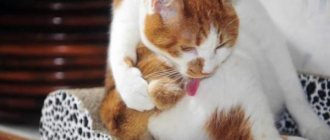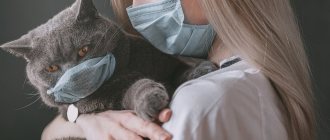Cats are very hygienic animals and spend most of their day clean. However, we should notice if they spend too much time grooming one area. If we see them licking their private areas almost constantly, we need to take a look. One of the reasons for this repetitive grooming may be due to a red and swollen butt. The first cause of this inflammation that we might think of is rectal prolapse, but it is important to know that there are several reasons why a cat's butt is red, many of which should be temporary.
We look at what happens when a cat has a swollen and red anus. We discuss possible causes and also find out what treatment can help your cat get rid of its problem.
Causes
Since there are no hair follicles in a cat's anal and rectal tissue, we can easily see them when the cat raises its tail. A healthy cat's butt should be light pink and look healthy. If it's too pale, it could be a sign of a problem. This is more difficult to detect than a swollen anus. When a cat's butt is swollen, it will likely be a different color, usually red or purple.
Inflammation of the anus and rectal mucosa is known as proctitis. Idiopathic proctitis occurs when there is no apparent cause, but a swollen and red butt is likely caused by one of the following:
© shutterstock
- Diseases of the gastrointestinal tract
- Tumors
- Inflammatory infection
- Obstructed anal glands
- Allergic reaction
- Foreign object
- Parasites
- Colitis
It is important to note the difference between a swollen butt and rectal prolapse. Rectal prolapse occurs when rectal tissue comes out through the anus. Although the anus will likely swell during this process, this is a secondary symptom of prolapse. Because prolapse is usually caused by a condition that requires the cat to strain to defecate, it is possible that the cat's anus will become swollen before this occurs.
The problem of anal inflammation in cats should be addressed, but in most cases it is not a serious problem and is usually fairly easy to treat. Rectal prolapse is considered a veterinary emergency and requires immediate attention.
Below we detail the main reasons why a cat has a swollen and red bottom.
Infectious panleukopenia
The more well-known name for the disease is feline distemper. A very contagious disease that affects cats of all age categories, however, 3-4 month old kittens are considered the most sensitive.
The infection does not pose a threat to humans or dogs, but it is better to isolate a sick or suspicious kitten and provide it with individual care. The panleukopenia virus is very stable in the external environment and is excreted in feces and vomit.
Therefore, it is important to periodically disinfect all care items (bedding, bowls, scratching posts, litter tray) both during and after treatment. There are special products for this that can be purchased at pet stores.
Methods of infection penetration:
- close contact with a sick animal (breeding, a trip to the country, an exhibition, contact with a stray kitten, a visit to a veterinary clinic);
- with dirty shoes (when you stepped on feces or vomit from a sick cat on the street);
- with other people's scratching posts, beds or houses (if you bring care items from a sick animal into the house).
Characteristic signs of the disease:
- depression, lack of appetite and reluctance to drink water;
- high body temperature (up to 41 degrees);
- emaciation and dehydration;
- shallow and rapid breathing;
- fearfulness and convulsions (with the nervous form of the disease);
- inflammation of the eyes and nose with purulent discharge, bronchitis, shortness of breath and heavy breathing;
- watery stools with mucus and foul odor;
- vomit.
An increase in the listed signs of a viral disease with a simultaneous drop in temperature below normal (37.5 degrees) in a cat poses a threat to life and inevitable death if timely treatment is not started.
Plague therapy consists of the primary administration of antiviral serum (examples of biological products: Vitafel S, Globfel-4). Apply three times, with an interval of 12-24 hours. Then, restorative therapy is carried out to combat dehydration through drip systems (Ringer's solutions, 5% glucose, sodium chloride are administered intravenously).
Broad-spectrum antibiotics (Enrofloxacin, Amoxicillin, Ceftriaxone) are prescribed for a course of 5-7 days. Additional medications include vitamins (water-soluble in a dropper) and means to support the heart and respiration (Sulphocamphocaine).
The disease is dangerous because in kittens the mortality rate reaches 90%. Adult cats that survive the first few days usually recover but remain contagious for 1 year
Therefore, it is so important to carry out frequent general cleaning of the premises and disinfect all animal care items.
Diseases of the gastrointestinal tract
The most common cause of anal inflammation in cats is some kind of gastrointestinal disease. It is an umbrella term for a variety of disorders that vary in symptoms and severity. Because it affects the digestive tract, it is often associated with what the cat eats, but not exclusively.
One of the common problems that cause gastrointestinal upset is poor diet. This may be because the cat is being fed poor food or the diet she is eating is not appropriate for her health. An improper diet often leads to diarrhea, like many other diseases of the gastrointestinal tract. This is one of the reasons why your cat may have a red butt or leak fluid.
Whether the stool is too soft or hard, your cat may irritate the anus, causing swelling. Loose stool can also accumulate around the anus, promoting bacterial growth and causing inflammation. However, constipation can also cause stimulation of the anus. If the stool is too large or hard, the strain puts pressure on the anus and causes swelling.
Treatment for this problem will depend on the cause of the gastrointestinal disease. If it's diarrhea, your cat may need more fluids to combat dehydration; if it's constipation, she may need fiber. Age also affects treatment.
Why does a cat ride on its butt and what to do about it
There may be several reasons why a cat rides on its butt. The reason for this animal behavior may be:
- inadequate, unbalanced nutrition;
- failure to comply with hygiene rules;
- suppression of sexual instincts;
- problems with bowel movements;
- infection in the anus;
- lack of movement;
- excess weight.
Why does a dog ride on its butt on the floor: what does it mean?
Excess weight and a sedentary lifestyle of a cat lead to the fact that the muscle tissue atrophies, it is replaced by a fatty layer that compresses the tissue, thereby disrupting the circulation of the anal glands.
Important! Most often, older animals suffer from this. If qualified medical care is not provided in time, this can lead to inflammatory processes in the rectum and even blood poisoning.
Older cats suffer from various ailments
Everyday problems
The cause of an adult animal or kitten rolling on its butt may be itching in the anus. The source of this behavior can be banal worms, which, crawling out of the rectum, irritate the anus. To relieve the itching, the pet begins to scratch it on the carpet. It is especially unpleasant to observe this after your pet has just gone to the toilet and leaves dirty, bad-smelling marks on a clean carpet.
Parasites can be found in any living organism. If a domestic cat does not go outside, this does not mean that she does not have worms. Helminth eggs can be found everywhere: on the soil, grass stems, they fly through the air, they can be carried into an apartment with shoes. Raw fish, meat products, and poor-quality water can be contaminated with parasite eggs.
Important! Regardless of whether a cat visits the street or not, once a quarter it must be rid of parasites that feed on its blood and poison the body with the products of its vital activity.
There are more than 30 varieties of helminths that can infect a pet. The most common of them are roundworms (also called tapeworms). Their appearance resembles spaghetti 5 cm long, sometimes more. They accumulate mainly in the small intestines.
The feeling of severe itching in the anus is caused by pinworms, which crawl out of the colon to lay their eggs in the anus. The desire to get rid of this itch causes animals to fidget on their butts on rough surfaces.
An abundance of tapeworms bursts the intestinal walls. Cats try to cleanse it of feces by stimulating the anus through an irritant, which is carpet.
The waste products of these parasites cause severe intoxication in the animal's body, which leads to allergies. Their large numbers can cause blockage of the bile ducts. Parasites such as Toxocara can even rupture a kitten's intestines. A baby can become infected not only through poor-quality food, but also in utero from a mother cat.
Note! Most often, parasites are found in river fish. Freezing does not kill them. Inside the fish, helminth larvae undergo a maturation process.
Blocked anal glands
The most common problem why a cat rides on its butt is blockage of the paraanal glands. Normal secretion is in a liquid state; when thickened, it becomes viscous, cannot pass through the narrow openings of the glands, clogs them and causes pain to the animal.
Metabolic disorders also cause thickening of secretions, the result of which is manifested by clogged ducts or copious discharge, causing inflammatory processes. Trying to eliminate inflammation and itching, the cat will crawl on its butt until it scratches the anus until it bleeds.
The cat begins to roll on its butt, trying to independently clean the holes through which the secretion is released. The cat's butt becomes red and he experiences discomfort.
Note! If independent attempts do not bring results, you should try to help him by pressing your fingers in the locations of the anal glands. It is better to do this procedure on the street or in the bathroom, since the liquid has a very pungent, persistent odor that is difficult to get rid of.
Inflammation of the paraanal glands
Often, blockage of the anal glands is accompanied by an inflammatory process, and then a veterinarian is indispensable. He may clean the area by inserting a catheter containing an antiseptic solution into the anus. In the case of purulent inflammation, in a veterinary clinic, it is possible to open the abscess, install drainage to drain the pus, and prescribe a course of antibiotics.
Attracts attention
Cats are very attentive and fast learning animals. Having once attracted attention to themselves with some action, they will try to repeat it again. So, having once ridden across the carpet on its butt and captured the owner’s attention, the cat will try to repeat it again and will do this every time in order to receive a portion of attention and care from the owner. You can wean your pet off of this only by giving him enough love and interest in his person.
Cats sometimes beg for their owner's attention.
The cat rides on its butt because pieces of feces are stuck to its fur.
Cats are very clean animals. They constantly wash themselves after eating, lick their fur, try to clean themselves after using the toilet, but it is not always possible to reach all the right places. A cat's butt may suffer from the banal sticking of excrement to the fur during toileting.
To clean it, the animal has to rub the area under its tail on the carpet or pieces of furniture. Most often this happens with liquid stool.
Note! This happens much more often in long-haired pets than in animals with short hair.
The coat in the area of excrement becomes dirty and sticks together, which leads to tightness of the skin and discomfort. The cats, wanting to correct the situation, begin to crawl on their butts. To avoid this, you should promptly trim the area around the anus and wash the animal from adhering feces.
Frequent bowel movements and diarrhea cause irritation and redness. In an effort to get rid of the itching, the cat rubs its butt on the carpet, as the best surface suitable for these purposes.
Constipation also brings little joy. If the intestines cannot be completely emptied, the cat tries to squeeze out the remaining feces from the rectum by rolling on the floor. In this case, it is worth helping your pet with laxatives and reviewing its diet. In addition, the animal should always have a bowl of clean, fresh drinking water available.
If a cat has a red butt, he licks himself twice as often
Another reason for fidgeting on the floor may be a foreign object that entered the stomach with food, and from there into the anus. It could be a piece of string from a sausage, a wrapper from a tasty treat, or a thread picked up on the floor.
After defecation, an object that is not completely expelled partially remains in the anus, causing discomfort to its inhabitant. The pet, trying to get rid of the object that irritates it, begins to rub against everything that can help get rid of it.
The greatest danger is cellophane. It cannot be dissolved by gastric juice, so it can block the functioning of the stomach, which will lead to the inevitable death of the animal. The owner should be attentive to what his pet eats, and, noticing foreign objects protruding from the anus, help get rid of them.
Note! After suffering an injury as a result of a fall or fractures in the hip joint, a pet in pain can ride on its butt, thus trying to relieve the pain from the injury. This is where sedatives prescribed by a veterinarian can come to the rescue.
A serious cause of butt riding in cats can be trauma on a psychological level. A mental disorder in an animal can be expressed in the form of loss of appetite, aggressive behavior, and unreasonable rolling on its butt, regardless of whether it went to the toilet or not. You can't do without a specialist here.
Anal tumors
Tumors are a type of growth that can develop on almost any part of the body, including the butt. Some are malignant, others are benign. However, even benign growths can cause suffering for a cat, especially if they are on the butt. They can negatively affect their ability to defecate and cause serious irritation.
Because your cat's anus is exposed to sunlight, it is possible that she may become infected with a skin cancer known as melanoma. However, squamous cell carcinoma most often affects a cat's anus. Fortunately, any type of anal cancer in cats is rare. If there are tumors on the butt or rectum, most likely these are benign tumors.
Treatment for any type of tumor will depend on its cause. Surgery is usually required. If the tumor is malignant, a combination of surgery, chemotherapy and/or radiation therapy may be required. The prognosis will depend on whether the cancer has metastasized to other parts of the cat's body.
Inflammatory infection
If your cat has a viral, bacterial or fungal infection, a swollen and red butt may be one of the symptoms. The types of these infections are incredibly varied, but they can be systemic or local.
With local infections, the cat may have a bacterial infection. If your cat's anus is injured due to strain or any other physical trauma affecting the area, bacteria will likely enter the wound. This often occurs through cat feces. Bacteria causing the infection can cause inflammation. If the infection is severe enough, your cat will need antibiotic treatment.
Typically, treatment will depend on the cause. In rare cases, antiviral drugs may be used for viral infections. Most often, treatment requires symptom relief until the body recovers.
© shutterstock
Prevention
As you know, it is easier to prevent a disease than to treat it later. If you follow some rules, you can protect not only the cat, but also yourself from these troubles, which are sometimes very difficult to deal with.
- If you do not give your cat raw meat or fish, you can avoid such a problem as worms in your cat. Raw foods must first be boiled and then fed to your pet.
- To prevent cats from getting worms, they need to be treated with anthelmintic medications once every 3 months.
- In order to avoid this problem, you need to keep your cat's litter box clean and disinfect it regularly.
- If you regularly treat your animal with a flea solution, your cat may not develop worms at all.
- Outdoor shoes should be stored in a special closet, away from the pet.
- It is necessary to do regular cleaning of the door mat.
- Do not pet the cat immediately after going outside; you need to wash your hands first.
- A bell on the animal's neck will prevent it from catching a mouse or bird, which could become a source of disease.
Prevention of the disease is important. If your pet is healthy, then the owner’s risk of contracting helminths will be significantly reduced, and a healthy animal will delight you with its playfulness and beautiful appearance.
Obstructed anal glands
A cat's anal glands are located near the anus. These glands are designed to both lubricate the anus during bowel movements and release scent to mark territory. Pheromones secreted by the anal glands (also known as anal sacs) help other cats identify them and learn information about them. Although this problem does not directly affect the butt, the location of the anal glands can cause the butt to become swollen and red.
Blockage of the gland duct can lead to the so-called anal sac disease. This means that the glands are exposed to secretions, often due to the accumulation of dirt. Especially in older cats, it is common for a caregiver or veterinarian to manually isolate the anal glands. If they don't, blockage occurs and a secondary infection develops. In extreme cases, this can lead to a painful abscess.
Causes of inflammation of the paraanal glands in cats
Typically, the anal glands in cats clean themselves during defecation or “spraying” secretions when marking the territory. At the same time, a small amount of this secretion, which looks like a light liquid, enters into the animal’s sphincter and is then released.
If there are any problems in the functioning of the gastrointestinal tract, the peri-anal ducts become clogged, become inflamed and bulge outward. The color of their secretion becomes brown, the consistency becomes thick, and the smell becomes extremely unpleasant.
Interesting! Scientists have found that long-haired pets who live in apartments suffer from blockage of the paraanal glands more often than other cats. However, among all domestic cats, this pathology, according to research by felinologists, occurs only in 1.5–2% of animals.
Inflammation of the anal glands most often occurs for the following reasons:
- Dysbacteriosis due to long-term use of antibiotics.
- Elderly age.
- Injuries.
- Worm infestation.
- Obesity.
- Eating small bones.
- Feeding with natural products or cheap liquid feed.
- Lack of physical activity.
- Injury to the anus.
- Pregnancy.
- The gland canals are too narrow from birth.
- Frequent constipation or, conversely, diarrhea due to problems in the gastrointestinal tract.
Allergic reaction
As we emphasized earlier, the butt consists of a certain type of skin tissue. As with other skin tissues, an allergic reaction may occur upon contact with the relevant allergen. Since the anus is on the cat's back, the problem is most likely to arise when the cat sits on something that contains an allergen.
An example would be a cat's sensitivity to a certain ingredient in a cleaning product. If the floor has just been cleaned with this product, your cat may develop contact dermatitis. The butt may become inflamed and red. In these cases, the veterinarian will likely rule out other possible causes first. The elimination process can then be carried out until the correct allergen is found.
How to recognize the disease?
Inflammation of the paraanal glands can be recognized by the following symptoms:
- The cat fidgets with its hind end on the floor.
- Nervously chews the tip of his tail.
- He licks the anus area vigorously.
- The animal may experience itching all over its body.
- In more severe cases, the cat develops an extremely painful abscess under its tail, which prevents it from going to the toilet normally.
- In the future, the abscess causes severe pain even in a calm state.
- The pet has an extremely unpleasant odor.
- When pressing on the anus area, unpleasant-smelling, viscous, dark-colored drops appear.










